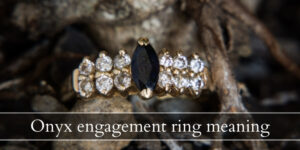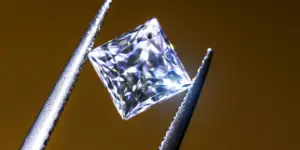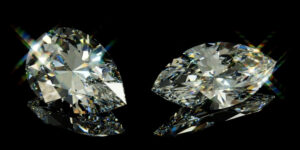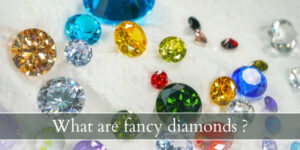When looking for angular diamonds you will always bump into emerald cuts and baguettes, and sometimes they’re mislabeled, or confused for one another. The thing is, these two diamond cutting styles are quite different and you could end up with a vastly different looking ring if you don’t know what you’re buying.
So let’s compare these two diamond cuts, see their pros and cons, and you’ll know which would be better for your situation. There is a time and a place for each of these.
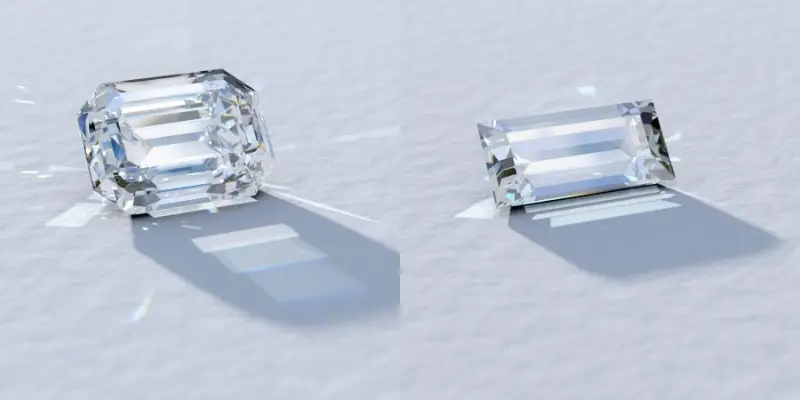
Emerald cut vs baguette cut diamonds
Emerald cut diamonds have more facets and sparkle than baguette cut diamonds, and are more often used as center stones for rings, pendants, or earrings. Baguettes are usually reserved for side stones. One way to distinguish a baguette cut from emerald cut is the corners – baguette cuts have sharp 90 degree corners while emerald cuts have truncated corners.
Both emerald cuts and baguette cuts are step cut styles, and they do not forgive a diamond’s flaw easily. Both emerald cuts and baguette will show a diamond’s tint and inclusions easily, especially the baguette cut.
What is emerald cut ?
Emerald cut is a type of diamond cut that is elongated, with truncated corners, and a series of long, thin facets that run parallel to each other. They resemble a very wide staircase leading down into the diamond, or mirrors facing each other. This type of diamond cut is very old, a variation on the old table cut.
The whole idea was to provide extra facets to get more sparkle out of the diamond, but also to keep it in a safe shape (no sharp corners). It’s called the emerald cut precisely because it was first applied to emeralds. This cut style preserves the most out of a rough emerald due to its crystal growth habit, and later the cut was applied to diamonds as well. Still, it was well known as the default cut for emeralds so the name stuck.
Read also: Princess VS Cushion Cut Diamonds
What is baguette cut ?
A baguette cut is a simple step-cut, in a rectangular shape with sharp 90 degree corners. It looks like an elongated table cut, with an extra set of facets on the pavilion. Like the emerald cut, the facets are long and thin and are facing each other. In a way you could say a baguette is a simplified emerald, less facets and the corners are not cut off.
This diamond is a very simple cut, and it’s most often used as an accent or side stone, rather than a center stone, at least as far as diamonds go. Now let’s compare emerald cuts and baguette cuts so you have a better idea of the differences between the two.
1. Baguettes have sharp corners, emerald cuts have tapered corners
A key difference in spotting a baguette among emerald cuts is the Corners. The corners of a baguette are always left sharp, at a 90 degree angle. This is mostly for aesthetic reasons, and the corners are usually protected by the diamond’s setting.
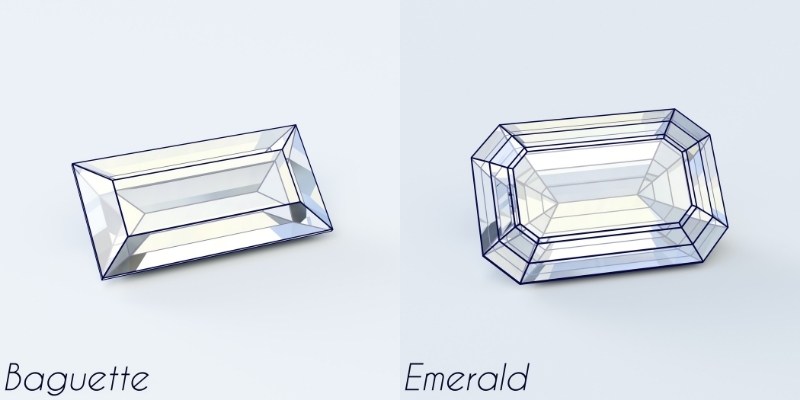
An emerald cut has cut corners for two reasons. First, a sharp corner is a weak point in a diamond, because it provides a place for the diamond to split or fracture. Diamonds don’t scratch or chip, because they’re tough, but the right hit in the right place and at the right angle can break it. So emerald cuts have the sharp points cut off, to keep the diamond safe
Second, an emerald cut has cut corners for extra sparkle. The more facets a diamond has, the more it will sparkle, so even though emerald cuts aren’t as impressive as round brilliant cuts, they still have a bit of sparkle going on around the edges.
2. Emerald is better for a center stone, baguette for side stones
Emerald cuts perform better than baguette cuts in many ways, so they are more often found as center stones than baguette cuts. An emerald cut gives a very elegant and understated look, especially compared to the dazzle of a round brilliant. The emerald cut is also considered a timeless classic, and associated with the Art Deco period when highly geometric patterns were all the rage. As such, emerald cuts were the go-to center stones.
Baguettes are better used as side stones, due to their simplicity. They don’t sparkle as much as an emerald cut but they work great to enhance or complete the look of a diamond center stone. Two of the most popular baguette types are the simple (rectangular) baguette and the tapered baguette.
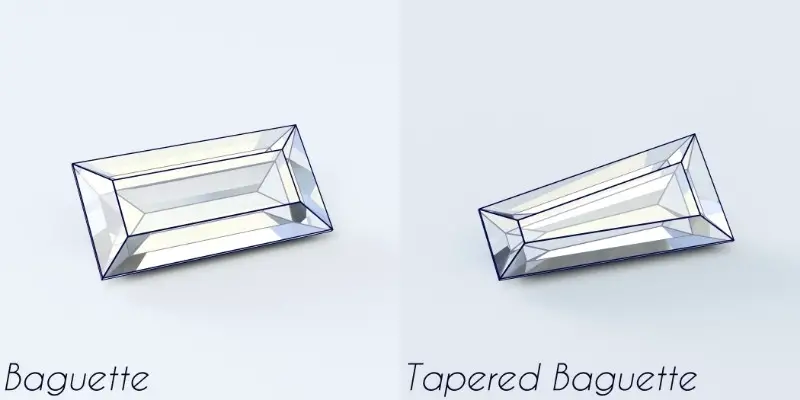
These two side stones go great with any step-cut center stone, such as an emerald cut, Asscher cut, lozenge, kite, or anything with a step-cut. Whenever you’re choosing the side stones they should be the same cut style as the center stone (as in step cut, mixed cut, or brilliant cut).
You won’t notice baguette cut diamonds right away, but if you think about it you’ll notice they’re often found in eternity rings, as accent stones for pendants or earrings, and in ballerina rings.
3. Baguette sparkles much less than emerald cut
We’ve mentioned that baguette cuts don’s sparkle as much as an emerald cut, and that is very true. The way a diamond’s sparkle works is that the light enters the cut diamond, splits into colored light, and inside within the diamond on all the facets, and then exits through the table back into your eyes as white and colored (rainbow) light. These are known as brilliance 9white) and fire (rainbow).
The more facets a diamond has, the more the light bounces and the more fire it has. When those facets are very small, the fire turns into brilliance and the overall look of the diamond may be more towards white rather than sparkly and colorful.
Read also: Fancy Cut Diamonds
So what about baguette cuts ? This cut style has perhaps the least amount of facets, and they are arranged in such a way that light does not split into many colorful flashes. Instead a baguette will reflect only occasionally, and those are wide flashes of white light. It’s a very simple diamond cut with only 14 facets.
Emerald cuts are more complex, they have more facets (57) and quite a few of them are at a angle with each other so the light will turn into both fire and brilliance. This is easiest to se towards the ends of the emerald cut, there the smaller and more angled facets are (pavilion and crown).
So if you’re looking for a sparkle factor, go for emerald instead of baguette. Just so you know, emerald cuts are not nearly as sparkly or impressive as a radiant cut, or a round brilliant. But they’re definitely catch the eye more than a baguette cut.

I’m the main author for jewelrymaterialguide.com. I started this site after we did tons of research before our wedding and noticed that there is information about rings, jewelry, and so on that is really hard to find on the internet.

